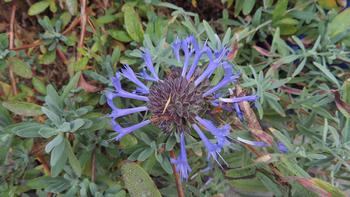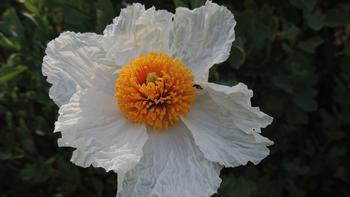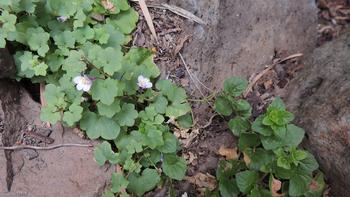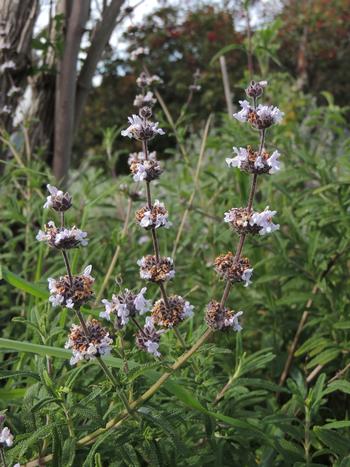How about some native scent in the garden?
-
Diane Lynch
-
As I transition to more natives in my very dry garden, some of the most appealing plants are the ones that flower for long periods and are fragrant. Fragrance can come from leaves or flowers, but leaves are fragrant all year and flowers are ephemeral. Consider planting some of these natives along walkways where they’ll get brushed, releasing scent.
 Salvia clevelandii is fragrant all year long and produces purple blooms all summer. Photo: Diane Lynch
Salvia clevelandii is fragrant all year long and produces purple blooms all summer. Photo: Diane LynchProbably the largest group of fragrant natives are the sages, or Salvias: S. spathacea, or hummingbird sage, blooms in early spring, depending on your location. S. clevelandii has fragrant leaves, purple flowers, and favors a bit of shade. Sonoma sage, S. sonomensis, is a sage green ground cover with lavender flowers. Black sage, S. mellifera, is highly aromatic with vertical whorls of tiny white flowers that are bee magnets. Salvia brandegei is an early spring bloomer with bluish to lavender flowers, which can grow to 6’. Purple sage, S. leucophylla, blooms pink in some gardens, with gray/silver foliage. White sage, S. apiana, is known to seed, giving you free plants; flower stalks can grow to 6’. Hummingbirds, bees, and butterflies are often attracted to sages. Sages and salvias occur around most of the world and some are more fragrant than others—give them the sniff test at the nursery.
The Matilija poppy, Romneya coulteri, is a spectacular white flower, apricot scented, sometimes dubbed fried egg plant, that’s the largest poppy in the world. A gallon pot over a few years can become a large plant, almost a garden thug, except for its summer beauty. It’s a good cut flower too! Romneya Coulteri produces spectacular flowers in the summer months. Photo: Diane Lynch
Romneya Coulteri produces spectacular flowers in the summer months. Photo: Diane LynchCalifornia sagebrush, Artemisia californica, has gray-green foliage and small yellow flowers and doesn’t need much water once established; nicknamed cowboy cologne, what some call the smell of California, and is sometimes used as a moth repellant.
Among the largest fragrant natives are Ceanothus or California lilac, which comes in many cultivars ranging from ground-covers to small trees. Its early spring beautiful blue or purple flowers are enticing to bees and butterflies.
Another large native is the buckeye tree, Aesculus californica, which leafs out in early spring, followed by large white, fragrant flowers. It loses its large leaves as early as July or August, prompting people to wonder if it’s dead, but this is how it protects itself from our customary summer droughts.
Yarrow or Achillea millefolium has fern-like fragrant foliage and beautiful round flat flowers in a variety of colors that bloom all summer. The Latin name comes from the legend that Achilles’ troops used it to treat wounds. Yerba buena likes shade and creeps around the garden needing very little water. Photo: Diane Lynch
Yerba buena likes shade and creeps around the garden needing very little water. Photo: Diane LynchThe unappealingly named California mugwort, Artemisia douglasiana, prefers partial shade and some moisture, making it suited for a creek bed should you be lucky enough to have one. The leaves smell of sage and are considered a topical antidote to poison oak if you’re fortunate enough to find some after a brush with the dreaded plant.
Yerba buena, Satureja douglasii, is a delightful little creeping plant that favors shade, especially under oaks. It needs very little water from the get-go, maybe a monthly drink for the first year. Little white flowers abound, and its leaves are reported to make a lovely mint tea.
Dune tansy, Tanacetum camphoratum, has fern-like foliage with a strong, bitter medicinal scent said to repel insects. Don’t plant this by the front door, but maybe near a plant you want to protect from the deer. Black sage has bright green foliage and lovely whorls of white or lavender blooms all summer long. Photo: Diane Lynch
Black sage has bright green foliage and lovely whorls of white or lavender blooms all summer long. Photo: Diane LynchMonardella villosa, commonly known as coyote mint, blooms from spring to fall in subtle purples and pinks, attracting butterflies and other insects. M. villosa var. obispoensis has round gray leaves enrobed in white fuzz. M. odoratissima, also called western pennyroyal, and M. undulata, also known as California bee balm, are other Monadellas worth considering.
Western spice bush, Calycanthus occidentalis, has flowers that resemble water lilies and, according to Glenn Keator, “the odor of old wine at close range.” Keator is a noted California native plant specialist, author, and educator.
This article barely scratches the surface of fragrant natives to consider for your garden. Right now, we’re coming into prime planting season for natives especially, so consider what you plan to add to your garden, and let’s all hope for rain this winter…




